Rethinking the Connections between Ecosystem Services, Pollinators, Pollution, and Health: Focus on Air Pollution and Its Impacts
Abstract
:1. Introduction
2. Ecosystem Services, Pollinators, and Biodiversity
2.1. Literature Quantitative Research Analysis
2.2. Ecosystem Services: Concept and Classification
- Provisioning services: material or energy products obtained from wild and cultivated plant species such as food, water, wood, fuels, non-wood products, etc., and medicinal products.
- Regulating services: the benefits obtained from the regulation of ecosystem processes, such as climate regulation through carbon sequestration, air quality, and the mitigation of extreme events, the prevention of erosion and fires, pollination, etc.
- Cultural services: non-material and perceptive benefits such as aesthetic and recreational value, spiritual, cognitive enrichment, etc.
- Support services: these are general services necessary for the production of other SEs. They can include primary production, nutrient cycling, soil enrichment, creating or maintaining habitats for various species, etc.
2.3. Pollination: A Regulating Ecosystem Service
3. Airborne Particulate Matter (PM) and Characteristics and Effects on Human Health and Pollinators: A Case of Study
3.1. Main Features of Airborne PM and Impact of Its Exposure on Human Health
3.2. The Contribution of the Honey Bee to Assess Airborne PM Pollution
3.3. Impact of the Exposure to Airborne PM on the Bee Health
4. Conclusions and Future Directions
Author Contributions
Funding
Conflicts of Interest
References
- Gómez-Baggethun, E.; de Groot, R.; Lomas, P.L.; Montes, C. The history of ecosystem services in economic theory and prac-tice: From early notions to markets and payment schemes. Ecol. Econ. 2010, 69, 1209–1218. [Google Scholar] [CrossRef]
- Costanza, R.; d’Arge, R.; de Groot, R.; Farber, S.; Grasso, M.; Hannon, B.; Limburg, K.; Naeem, S.; O’Neill, R.V.; Paruelo, J.; et al. The value of the world’s ecosystem services and natural capital. Nature 1997, 387, 253–260. [Google Scholar] [CrossRef]
- Pharo, E.; Daily, G.C. Nature’s Services: Societal Dependence on Natural Ecosystems; Yale University Press: London, UK, 1997; pp. 454–464. [Google Scholar] [CrossRef] [Green Version]
- Costanza, R.; de Groot, R.; Sutton, P.; van der Ploeg, S.; Anderson, S.J.; Kubiszewski, I.; Farber, S.; Turner, R.K. Changes in the global value of ecosystem services. Glob. Environ. Chang. 2014, 26, 152–158. [Google Scholar] [CrossRef]
- Pascual, U.; Muradian, R.; Brander, L.; Gómez-Baggethun, E.; Martín-López, B.; Verma, M.; Armsworth, P.; Christie, M.; Cornelissen, H.; Eppink, F. The Economics of Valuing Ecosystem Services and Biodiversity; TEEB–Ecological and Economic Foundation: London, UK, 2010. [Google Scholar]
- Acharya, R.P.; Maraseni, T.; Cockfield, G. Global trend of forest ecosystem services valuation–An analysis of publications. Ecosyst. Serv. 2019, 39, 100979. [Google Scholar] [CrossRef]
- Osman, M.A.M.; Shebl, M.A. Vulnerability of Crop Pollination Ecosystem Services to Climate Change. In Climate Change Impacts on Agriculture and Food Security in Egypt; Ewis Omran, E.S., Negm, A., Eds.; Springer: Cham, Switzerland, 2020. [Google Scholar]
- Leal Filho, W. (Ed.) Supporting Ecosystem Services: Concepts and Linkages to Sustainability. In Life on Land, Encyclopedia of the UN Sustainable Development Goals; Springer Nature Switzerland AG: Cham, Switzerland, 2020. [Google Scholar]
- Ghisbain, G.; Gérard, M.; Wood, T.J.; Hines, H.M.; Michez, D. Expanding insect pollinators in the Anthropocene. Biol. Rev. 2021, 96, 2755–2770. [Google Scholar] [CrossRef] [PubMed]
- Gao, J.-G.; Liu, H.; Wang, N.; Yang, J.; Zhang, X.-L. Plant extinction excels plant speciation in the Anthropocene. BMC Plant Biol. 2020, 20, 430. [Google Scholar] [CrossRef] [PubMed]
- Scherer, L.; Svenning, J.-C.; Huang, J.; Seymour, C.; Sandel, B.; Mueller, N.; Kummu, M.; Bekunda, M.; Bruelheide, H.; Hochman, Z.; et al. Global priorities of environmental issues to combat food insecurity and biodiversity loss. Sci. Total Environ. 2020, 730, 139096. [Google Scholar] [CrossRef]
- Aerts, R.; Honnay, O.; Van Nieuwenhuyse, A. Biodiversity and human health: Mechanisms and evidence of the positive health e_ects of diversity in nature and green spaces. Br. Med. Bull. 2018, 127, 5–22. [Google Scholar] [CrossRef] [Green Version]
- Classen, A.; Peters, M.K.; Ferger, S.W.; Helbig-Bonitz, M.; Schmack, J.M.; Maassen, G.; Schleuning, M.; Kalko, E.K.; Böhning-Gaese, K.; Steffan-Dewenter, I. Complementary ecosystem services provided by pest predators and pollinators increase quantity and quali-ty of coffee yields. Proc. R. Soc. B 2014, 281, 20133148. [Google Scholar] [CrossRef]
- Malhi, Y.; Franklin, J.; Seddon, N.; Solan, M.; Turner, M.G.; Field, C.B.; Knowlton, N. Climate change and ecosystems: Threats, opportunities and solutions. Phil. Trans. R. Soc. B 2020, 375, 20190104. [Google Scholar] [CrossRef] [Green Version]
- Konczak, B.; Cempa, M.; Pierzchala, L.; Deska, M. Assessment of the ability of roadside vegetation to remove particulate matter from the urban air. Environ. Pollut. 2021, 268, 1154652. [Google Scholar] [CrossRef] [PubMed]
- Grote, R.; Samson, R.; Alonso, R.; Amorim, J.H.; Cariñanos, P.; Churkina, G.; Fares, S.; Le Thiec, D.; Niinemets, Ü.; Mikkelsen, T.N.; et al. Functional traits of urban trees: Air pollution mitigation potential. Front. Ecol. Environ. 2016, 14, 543–550. [Google Scholar] [CrossRef]
- Abhijith, K.; Kumar, P.; Gallagher, J.; McNabola, A.; Baldauf, R.; Pilla, F.; Broderick, B.; DI Sabatino, S.; Pulvirenti, B. Air pollution abatement performances of green infrastructure in open road and built-up street canyon environments–A review. Atmos. Environ. 2017, 162, 71–86. [Google Scholar] [CrossRef]
- Chen, X.; Pei, T.; Zhou, Z.; Teng, M.; He, L.; Luo, M.; Liu, X. Efficiency differences of roadside greenbelts with three configu-rations in removing coarse particles (PM10): A street scale investigation in Wuhan, China. Urban For. Urban Green. 2015, 14, 354e360. [Google Scholar] [CrossRef]
- Van Eck, N.J.; Waltman, L. Software survey: VOSviewer, a computer program for bibliometric mapping. Scientometrics 2010, 84, 523–538. [Google Scholar] [CrossRef] [PubMed] [Green Version]
- Van Eck, N.J.; Waltman, L. Text mining and visualization using VOSviewer. arXiv 2011, arXiv:1109.2058. Available online: https://arxiv.org/ftp/arxiv/papers/1109/1109.2058.pdf (accessed on 23 October 2021).
- Waltman, L.; van Eck, N.J.; Noyons, E.C.M. A unified approach to mapping and clustering of bibliometric networks. J. Informetr. 2010, 4, 629–635. [Google Scholar] [CrossRef] [Green Version]
- Kearns, C.A.; Inouye, D.W.; Waser, N.M. ENDANGERED MUTUALISMS: The Conservation of Plant-Pollinator Interactions. Annu. Rev. Ecol. Syst. 1998, 29, 83–112. [Google Scholar] [CrossRef]
- Dong, Q. Ecosystem services: The biological conditions and ecological supports necessary for the development of human soci-eties. Chin. J. Appl. Ecol. 1999, 10, 233–240. [Google Scholar]
- Naeem, S.; Bunker, D.E.; Hector, A.; Loreau, M.; Perrings, C. Biodiversity, Ecosystem Functioning, and Human Wellbeing: An Ecological and Economic Perspective; Oxford University Press: Oxford, UK, 2009; pp. 1–384. ISBN 9780199547951. [Google Scholar]
- Brockerhoff, E.G.; Barbaro, L.; Castagneyrol, B.; van der Plas, F.; Jactel, H. Forest biodiversity, ecosystem functioning and the provision of ecosystem services. Biodivers. Conserv. 2017, 26, 3005–3035. [Google Scholar] [CrossRef] [Green Version]
- Dalsgaard, B. Land-Use and Climate Impacts on Plant–Pollinator Interactions and Pollination Services. Diversity 2020, 12, 168. [Google Scholar] [CrossRef]
- Brittain, C.; Potts, S.G. The potential impacts of insecticides on the life-history traits of bees and the consequences for pollina-tion. Bas. App. Ecol. 2011, 111, 76–85. [Google Scholar]
- Breeze, T.; Bailey, A.; Potts, S.; Balcombe, K. A stated preference valuation of the non-market benefits of pollination services in the UK. Ecol. Econ. 2015, 111, 76–85. [Google Scholar] [CrossRef]
- Martin, E.A.; Dainese, M.; Clough, Y.; Zubair-Anjum, M.; Steffan-Dewenter, I. The interplay of landscape composition and configuration: New pathways to manage functional biodiversity and agroecosystem services across Europe. Ecol. Lett. 2019, 2, 1083–1094. [Google Scholar] [CrossRef] [PubMed] [Green Version]
- Holzschuh, A.; Dainese, M.; González-Varo, J.P.; Mudri-Stojnić, S.; Riedinger, V.; Rundlöf, M.; Scheper, J.; Wickens, J.; Wickens, V.; Bommarco, R.; et al. Mass-flowering crops dilute pollinator abundance in agricultural landscapes across Europe. Ecol. Lett. 2016, 19, 1228–1236. [Google Scholar] [CrossRef] [PubMed]
- Gardner, E.; Breeze, T.D.; Clough, Y.; Wilby, A.; Oliver, T.H. Field boundary features can stabilise bee populations and the pollination of mass-flowering crops in rotational systems. J. App. Ecol. 2021, 58, 2287–2304. [Google Scholar] [CrossRef]
- Willden, S.A.; Pritts, M.P.; Loeb, G.M. The effect of plastic low tunnels on natural enemies and pollinators in New York strawberry. Crop Prot. 2021, 151, 105820. [Google Scholar] [CrossRef]
- Osterman, J.; Aizen, M.A.; Biesmeijer, J.C.; Seymour, C.L.; Paxton, R.J. Global trends in the number and diversity of managed pollinator species. Agric. Ecosyst. Environ. 2021, 322, 107653. [Google Scholar] [CrossRef]
- Staton, T.; Breeze, T.D.; Walters, R.J.; Smith, J.; Girling, R.D. Productivity, biodiversity trade-offs, and farm income in an ag-roforestry versus an arable system. Ecol. Econ. 2022, 191, 107214. [Google Scholar] [CrossRef]
- Baho, D.L.; Bundschuh, M.; Futter, M.N. Microplastics in terrestrial ecosystems: Moving beyond the state of the art to mini-mize the risk of ecological surprise. Glob. Chang. Biol. 2021, 27, 3969–3986. [Google Scholar] [CrossRef]
- Kevan, P.G.; Shipp, L.; Smagghe, G. Ecological Intensification: Managing Biocomplexity and Biodiversity in Agriculture Through Pollinators, Pollination and Deploying Biocontrol Agents against Crop and Pollinator Diseases, Pests and Parasites. In Entomovectoring for Precision Biocontrol and Enhanced Pollination of Crops; Springer: Berlin/Heidelberg, Germany, 2020; pp. 19–51. [Google Scholar] [CrossRef]
- Muschler, R.G. Agroforestry: Essential for sustainable and climate-smart land use? In Tropical Forestry Handbook, 2nd ed.; Springer: Berlin/Heidelberg, Germany, 2016; pp. 2013–2116. [Google Scholar]
- DeLonge, M.S.; Miles, A.; Carlisle, L. Investing in the transition to sustainable agriculture. Environ. Sci. Policy 2016, 55, 266–273. [Google Scholar] [CrossRef] [Green Version]
- Underwood, T.; McCullum-Gómez, C.; Harmon, A.; Roberts, S. Organic Agriculture Supports Biodiversity and Sustainable Food Production. J. Hunger Environ. Nutr. 2011, 6, 398–423. [Google Scholar] [CrossRef]
- Dumont, B.; Fortun-Lamothe, L.; Jouven, M.; A Thomas, M.; Tichit, M. Prospects from agroecology and industrial ecology for animal production in the 21st century. Animal 2013, 7, 1028–1043. [Google Scholar] [CrossRef] [PubMed] [Green Version]
- Kumaraswamy, S.; Kunte, K. Integrating biodiversity and conservation with modern agricultural landscapes. Biodivers. Conserv. 2013, 22, 2735–2750. [Google Scholar] [CrossRef]
- Myers, S.S.; Gaffikin, L.; Golden, C.D.; Turner, W.R.; Osofsky, S.A. Human health impacts of ecosystem alteration. Proc. Natl. Acad. Sci. USA 2013, 110, 18753–18760. [Google Scholar] [CrossRef] [Green Version]
- MEA (Millennium Ecosystem Assessment). Ecosystems and Human Well-Being: Sythesis; Island Press: Washington, DC, USA, 2005. [Google Scholar]
- Costanza, R.; de Groot, R.; Braat, L.; Kubiszewski, I.; Fioramonti, L.; Sutton, P.; Farber, S.; Grasso, M. Twenty years of ecosys-tem services: How far have we come and how far do we still need to go? Ecosyst. Serv. 2017, 28, 1–16. [Google Scholar] [CrossRef]
- TEEB. The Economics of Ecosystems and Biodiversity: Ecological and Economic Foundations; Kumar, P., Ed.; Earthscan: London, UK; Washington, DC, USA, 2010. [Google Scholar]
- Haines-Young, R.; Potschin, M.B. Common International Classification of Ecosystem Services (CICES) V5.1 and Guidance on the Application of the Revised Structure, Version 5.1. 2018. Available online: www.cices.eu (accessed on 18 December 2021).
- Baskent, E.Z. A Framework for Characterizing and Regulating Ecosystem Services in a Management Planning Context. Forests 2020, 11, 102. [Google Scholar] [CrossRef] [Green Version]
- Alcamo, J.; Ash, N.J.; Butler, C.D.; Callicot, J.B.; Capistrano, D.; Carpenter, S.R. Ecosystems and Human WellBeing: A Framework for Assessment; Island Press: Washington, DC, USA, 2003. [Google Scholar]
- Barten, P.; Jones, J.; Achterman, G. Hydrologic Effects of a Changing Forest Landscape; National Academies Press: Washington, DC, USA, 2008; 180p. [Google Scholar]
- Winkler, R.; Spittlehouse, D.; Boon, S. Streamflow response to clear-cut logging on British Columbia’s Okanagan Plateau. Ecohydrology 2017, 10, e1836. [Google Scholar] [CrossRef]
- Maes, J.; Teller, A.; Erhard, M.; Liquete, C.; Braat, L.; Berry, P.; Egoh, B.; Puydarrieux, P.; Fiorina, C.; Santos, F. Mapping and Assessment of Ecosystems and their Services. Anal. Framew. Ecosyst. Assess. Action 2013, 5, 1–58. [Google Scholar]
- Daniel, T.C.; Muhar, A.; Arnberger, A.; Aznar, O.; Boyd, J.W.; Chan, K.M.; Grêt-Regamey, A. Contribution of cultural ser-vices to the ecosystem services agenda. Proc. Natl. Acad. Sci. USA 2012, 109, 8812–8819. [Google Scholar] [CrossRef] [Green Version]
- Klein, A.-M.; Vaissière, B.E.; Cane, J.H.; Steffan-Dewenter, I.; Cunningham, S.A.; Kremen, C.; Tscharntke, T. Importance of pollinators in changing landscapes for world crops. Proc. R. Soc. B Biol. Sci. 2007, 274, 303–313. [Google Scholar] [CrossRef] [PubMed] [Green Version]
- Gallai, N.; Salles, J.-M.; Settele, J.; Vaissière, B.E. Economic valuation of the vulnerability of world agriculture confronted with pollinator decline. Ecol. Econ. 2009, 68, 810–821. [Google Scholar] [CrossRef]
- Thakur, M. Bees as Pollinators–Biodiversity and Conservation. Int. Res. J. Agric. Sci. Soil Sci. 2012, 002, 1–7. [Google Scholar]
- McGregor, S.E. Insect Pollination of Cultivated Crop Plants; Agriculture Handbook; Agricultural Research Service, US Department of Agriculture: Washington, DC, USA, 1976; Volume 496, pp. 1–7.
- Kevan, P.G. Pollinators as bioindicators of the state of the environment: Species, activity and diversity. Agric. Ecosyst. Environ. 1999, 74, 373–393. [Google Scholar] [CrossRef]
- Kevan, P. Alternative pollinators for Ontario’s crops. Proc. Entomol. Soc. Ontario. 1987, 118, 109–170. [Google Scholar]
- Krunic, M.D.; Terzić, L.R.; Kulincevic, J.M. Honey resistance to air contamination with arsenic from a copper processing plant. Apidologie 1989, 20, 251–255. [Google Scholar] [CrossRef] [Green Version]
- Bunzl, K.; Kracke, W.; Vorwohl, G. Transfer of Chernobyl-derived 134Cs, 137Cs, 131I and 103Ru from flowers to honey and pollen. J. Environ. Radioact. 1988, 6, 261–269. [Google Scholar] [CrossRef]
- Ford, B.C.; Jester, W.A.; Griffith, S.M.; Morse, R.A.; Zall, R.R.; Burgett, D.M.; Bodyfelt, F.W.; Lisk, D.J. Cesium-134 and Ce-sium-137 in honey bees and cheese samples collected in the US after the Chernobyl accident. Chemosphere 1988, 17, 1153–1157. [Google Scholar] [CrossRef]
- Dewey, J.E. Accumulation of Fluorides by Insects Near an Emission Source in Western Montana. Environ. Èntomol. 1973, 2, 179–182. [Google Scholar] [CrossRef]
- Stein, K.; Umland, F. Mobile und immobile Probensammlung mit Hilfe von Bienen und Birken. Anal. Bioanal. Chem. 1987, 327, 132–141. [Google Scholar] [CrossRef]
- Anderson, J.F.; Wojtas, M.A. Honey bees (Hymenoptera: Apidae) contaminated with pesticides and polychlorinated biphen-yls. J. Econ. Entomol. 1986, 79, 1200–1205. [Google Scholar] [CrossRef]
- Morse, R.A.; Culliney, T.W.; Gutenmann, W.H.; Littman, C.B.; Lisk, D.J. Polychlorinated biphenyls in honey bees. Bull. Environ. Contam. Toxicol. 1987, 38, 271–276. [Google Scholar] [CrossRef] [PubMed]
- Rousseau, M. Les abeilles domestiques et la pollution de l’environnement. Bull. Office Int. Epizooites. 1972, 77, 1473–1480. [Google Scholar]
- Drescher, W. Die Eignung der Bienen als Indikatoren für Umweltbelastungen. Decheniana 1982, 26, 171–177. [Google Scholar]
- Bromenshenk, J.J.; Carlson, S.R.; Simpson, J.C.; Thomas, J.M. Pollution Monitoring of Puget Sound with Honey Bees. Science 1985, 227, 632–634. [Google Scholar] [CrossRef]
- Adeoye, O.T.; Pitan, O.R.; Olasupo, O.O.; Ayandokun, A.E.; Abudul-Azeez, F.I. Honeybees as bioindicators of ecotocixity. Aust. J. Sci. Technol. 2021, 5, 460–465. [Google Scholar]
- Brown, J.S.; Gordon, T.; Price, O.; Asgharian, B. Thoracic and respirable particle definitions for human health risk assessment. Part. Fibre Toxicol. 2013, 10, 12. [Google Scholar] [CrossRef] [Green Version]
- Cadelis, G.; Tourres, R.; Molinie, J. Short-Term Effects of the Particulate Pollutants Contained in Saharan Dust on the Visits of Children to the Emergency Department due to Asthmatic Conditions in Guadeloupe (French Archipelago of the Caribbean). PLoS ONE 2014, 9, e91136. [Google Scholar] [CrossRef] [Green Version]
- Yu, X.-B.; Su, J.-W.; Li, X.-Y.; Chen, G. Short-Term Effects of Particulate Matter on Stroke Attack: Meta-Regression and Meta-Analyses. PLoS ONE 2014, 9, e95682. [Google Scholar] [CrossRef]
- Lanphear, B.P. Low-level toxicity of chemicals: No acceptable levels? PLoS Biol. 2017, 15, e2003066. [Google Scholar] [CrossRef]
- Kish, L.; Hotte, N.; Kaplan, G.G.; Vincent, R.; Tso, R.; Gänzle, M.; Rioux, K.P.; Thiesen, A.; Barkema, H.W.; Wine, E.; et al. Environmental Particulate Matter Induces Murine Intestinal Inflammatory Responses and Alters the Gut Microbi-ome. PLoS ONE 2013, 8, e62220. [Google Scholar] [CrossRef] [Green Version]
- Lomer, M.C.E.; Thompson, R.P.H.; Powell, J.J. Fine and ultrafine particles of the diet: Influence on the mucosal immune re-sponse and association with Crohn’s disease. Proc. Nutr. Soc. 2002, 61, 123–130. [Google Scholar] [CrossRef] [PubMed] [Green Version]
- Salim, S.Y.; Jovel, J.; Wine, E.; Kaplan, G.G.; Vincent, R.; Thiesen, A.; Barkema, H.W.; Madsen, K.L. Exposure to Ingested Airborne Pollutant Particulate Matter Increases Mucosal Exposure to Bacteria and Induces Early Onset of Inflammation in Neonatal IL-10–Deficient Mice: Inflammatory Bowel Diseases. Inflamm. Bowel Dis. 2014, 20, 1129–1138. [Google Scholar] [CrossRef] [PubMed]
- Donaldson, K.; A Murphy, F.; Duffin, R.; A Poland, C. Asbestos, carbon nanotubes and the pleural mesothelium: A review and the hypothesis regarding the role of long fibre retention in the parietal pleura, inflammation and mesothelioma. Part. Fibre Toxicol. 2010, 7, 5. [Google Scholar] [CrossRef] [PubMed] [Green Version]
- Riediker, M.; Zink, D.; Kreyling, W.; Oberdörster, G.; Elder, A.; Graham, U.; Lynch, I.; Duschl, A.; Ichihara, G.; Ichihara, S.; et al. Particle toxicology and health-where are we? Part. Fibre Toxicol. 2019, 16, 19. [Google Scholar] [CrossRef] [PubMed]
- Belardi, G.; Vignaroli, G.; Trapasso, F.; Pacella, A.; Passeri, D. Detecting asbestos fbres and cleavage fragments produced afer mechanical tests on ophiolite rocks: Clues for the asbestos hazard evaluation. J. Mediterr. Earth Sci. 2018, 10, 63–78. [Google Scholar] [CrossRef]
- Maher, B.A.; Ahmed, I.A.M.; Karloukovski, V.; MacLaren, D.A.; Foulds, P.G.; Allsop, D.; Mann, D.M.A.; Torres-Jardón, R.; Calderon-Garciduenas, L. Magnetite pollution nanoparticles in the human brain. Proc. Natl. Acad. Sci. USA 2016, 113, 10797–10801. [Google Scholar] [CrossRef] [Green Version]
- Bencsik, A.; Lestaevel, P.; Canu, I.G. Nano- and neurotoxicology: An emerging discipline. Prog. Neurobiol. 2018, 160, 45–63. [Google Scholar] [CrossRef] [Green Version]
- Schraufnagel, D.E. The health effects of ultrafine particles. Exp. Mol. Med. 2020, 52, 311–317. [Google Scholar] [CrossRef]
- Dashtipour, K.; Liu, M.; Kani, C.; Dalaie, P.; Obenaus, A.; Simmons, D.; Gatto, N.M.; Zarifi, M. Iron Accumulation Is Not Homogenous among Patients with Parkinson’s Disease. Park. Dis. 2015, 2015, 324843. [Google Scholar] [CrossRef]
- Soltani, N.; Keshavarzi, B.; Sorooshian, A.; Moore, F.; Dunster, C.; Dominguez, A.O.; Kelly, F.J.; Dhakal, P.; Ahmadi, M.R.; Asadi, S. Oxidative potential (OP) and mineralogy of iron ore particulate matter at the Gol-E-Gohar Mining and Industrial Facility (Iran). Environ. Geochem. Health 2017, 40, 1785–1802. [Google Scholar] [CrossRef] [PubMed]
- Jan, R.; Roy, R.; Bhor, R.; Pai, K.; Satsangi, P.G. Toxicological screening of airborne particulate matter in atmosphere of Pune: Reactive oxygen species and cellular toxicity. Environ. Pollut. 2019, 261, 113724. [Google Scholar] [CrossRef] [PubMed]
- Toy, R.; Peiris, P.M.; Ghaghada, K.B.; Karathanasis, E. Shaping cancer nanomedicine: The effect of particle shape on the in vivo journey of nanoparticles. Nanomedicine 2014, 9, 121–134. [Google Scholar] [CrossRef] [Green Version]
- Porrini, C.; Sabatini, A.G.; Girotti, S.; Ghini, S.; Medrzycki, P.; Grillenzoni, F.; Bortolotti, L.; Gattavecchia, E.; Celli, G. Honey bees and bee products as monitors of the environmental contamination. Apiacta 2003, 38, 63–70. [Google Scholar]
- Satta, A.; Verdinelli, M.; Ruiu, L.; Buffa, F.; Salis, S.; Sassu, A.; Floris, I. Combination of beehive matrices analysis and ant bi-odiversity to study heavy metal pollution impact in a post-mining area (Sardinia, Italy). Environ. Sci Pollut. Res. 2012, 19, 3977–3988. [Google Scholar] [CrossRef] [PubMed]
- Perugini, M.; Manera, M.; Grotta, L.; Abete, M.C.; Tarasco, R.; Amorena, M. Heavy Metal (Hg, Cr, Cd, and Pb) Contamina-tion in Urban Areas and Wildlife Reserves: Honeybees as Bioindicators. Biol. Trace Elem. Res. 2011, 140, 170–176. [Google Scholar] [CrossRef]
- Porrini, C.; Mutinelli, F.; Bortolotti, L.; Granato, A.; Laurenson, L.; Roberts, K.; Gallina, A.; Silvester, N.; Medrzycki, P.; Renzi, T.; et al. The Status of Honey Bee Health in Italy: Results from the Nationwide Bee Monitoring Net-work. PLoS ONE 2016, 11, e0155411. [Google Scholar] [CrossRef]
- Giglio, A.; Ammendola, A.; Battistella, S.; Naccarato, A.; Pallavicini, A.; Simeon, E.; Tagarelli, A.; Giulianini, P.G. Apis mellif-era ligustica, Spinola 1806 as bioindicator for detecting environmental contamination: A preliminary study of heavy metal pol-lution in Trieste, Italy. Environ. Sci. Pollut. Res. 2017, 24, 659–665. [Google Scholar] [CrossRef] [PubMed]
- Goretti, E.; Pallottini, M.; Rossi, R.; La Porta, G.; Gardi, T.; Goga, B.C.; Elia, A.C.; Galletti, M.; Moroni, B.; Petroselli, C.; et al. Heavy metal bioaccumulation in honey bee matrix, an indicator to assess the contamination level in terrestrial environments. Environ. Pollut. 2019, 256, 113388. [Google Scholar] [CrossRef]
- Martinello, M.; Manzinello, C.; Dainese, N.; Giuliato, I.; Gallina, A.; Mutinelli, F. The Honey Bee: An Active Biosampler of Environmental Pollution and a Possible Warning Biomarker for Human Health. Appl. Sci. 2021, 11, 6481. [Google Scholar] [CrossRef]
- Negri, I.; Mavris, C.; Di Prisco, G.; Caprio, E.; Pellecchia, M. Honey Bees (Apis mellifera, L.) as Active Samplers of Airborne Particulate Matter. PLoS ONE 2015, 10, e0132491. [Google Scholar] [CrossRef] [PubMed] [Green Version]
- Pellecchia, M.; Negri, I. Particulate matter collection by honey bees (Apis mellifera L.) near to a cement factory in Italy. PeerJ 2018, 6, e5322. [Google Scholar] [CrossRef] [PubMed] [Green Version]
- Papa, G.; Capitani, G.; Capri, E.; Pellecchia, M.; Negri, I. Vehicle-derived ultrafine particulate contaminating bees and bee products. Sci. Total Environ. 2020, 750, 141700. [Google Scholar] [CrossRef] [PubMed]
- Capitani, G.; Papa, G.; Pellecchia, M.; Negri, I. Disentangling multiple PM emission sources in the Po Valley (Italy) using honey bees. Heliyon 2021, 7, e06194. [Google Scholar] [CrossRef] [PubMed]
- Vaknin, Y.; Gan-Mor, S.; Bechar, A.; Ronen, B.; Eisikowitch, D. The role of electrostatic forces in pollination. Oesterreichische Bot. Z. 2000, 222, 133–142. [Google Scholar] [CrossRef]
- Bonmatin, J.-M.; Giorio, C.; Girolami, V.; Goulson, D.; Kreutzweiser, D.P.; Krupke, C.; Liess, M.; Long, E.; Marzaro, M.; Mitchell, E.A.D.; et al. Environmental fate and exposure; neonicotinoids and fipronil. Environ. Sci. Pollut. Res. 2015, 22, 35–67. [Google Scholar] [CrossRef]
- Papa, G.; Capitani, G.; Pellecchia, M.; Negri, I. Particulate Matter Contamination of Bee Pollen in an Industrial Area of the Po Valley (Italy). Appl. Sci. 2021, 11, 11390. [Google Scholar] [CrossRef]
- AL Naggar, Y.; Dabour, K.; Masry, S.; Sadek, A.; Naiem, E.; Giesy, J.P. Sublethal effects of chronic exposure to CdO or PbO nanoparticles or their binary mixture on the honey bee (Apis millefera L.). Environ. Sci. Pollut. Res. 2018, 27, 19004–19015. [Google Scholar] [CrossRef]
- Feldhaar, H.; Otti, O. Pollutants and Their Interaction with Diseases of Social Hymenoptera. Insects 2020, 11, 153. [Google Scholar] [CrossRef] [Green Version]
- Dabour, K.; Al Naggar, Y.; Masry, S.; Naiem, E.; Giesy, J.P. Cellular alterations in midgut cells of honey bee workers (Apis millefera L.) exposed to sublethal concentrations of CdO or PbO nanoparticles or their binary mixture. Sci. Total Environ. 2018, 651, 1356–1367. [Google Scholar] [CrossRef]
- Ferrara, G.; Salvaggio, A.; Pecoraro, R.; Scalisi, E.M.; Presti, A.M.; Impellizzeri, G.; Brundo, M.V. Toxicity assessment of nano-TiO2 in APIS MELLIFERA L.; 1758: Histological and immunohistochemical assays. Microsc. Res. Tech. 2020, 83, 332–337. [Google Scholar] [CrossRef] [PubMed]
- Papa, G.; Di Prisco, G.; Spini, G.; Puglisi, E.; Negri, I. Acute and chronic effects of Titanium dioxide (TiO2) PM1 on honeybee gut microbiota under laboratory conditions. Sci. Rep. 2021, 11, 5946. [Google Scholar] [CrossRef] [PubMed]
- Raymann, K.; Moran, N.A. The role of the gut microbiome in health and disease of adult honey bee workers. Curr. Opin. Insect. Sci. 2018, 26, 97–104. [Google Scholar] [CrossRef] [PubMed]
- Marquardt, M.; Kienbaum, L.; Kretschmer, L.A.; Penell, A.; Schweikert, K.; Ruttensperger, U.; Rosenkranz, P. Evaluation of the importance of ornamental plants for pollinators in urban and suburban areas in Stuttgart, Germany. Urban Ecosyst. 2020, 24, 811–825. [Google Scholar] [CrossRef]


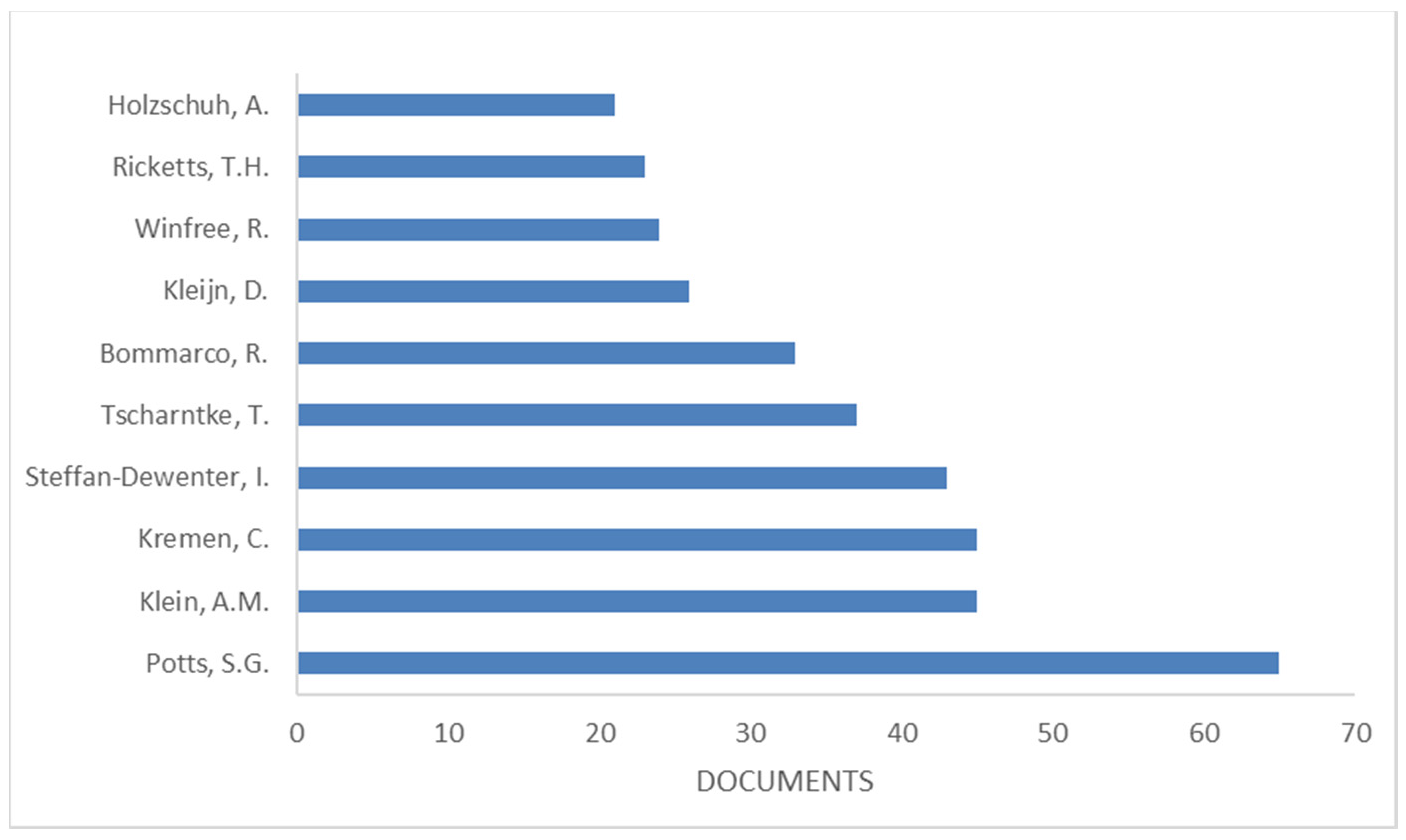
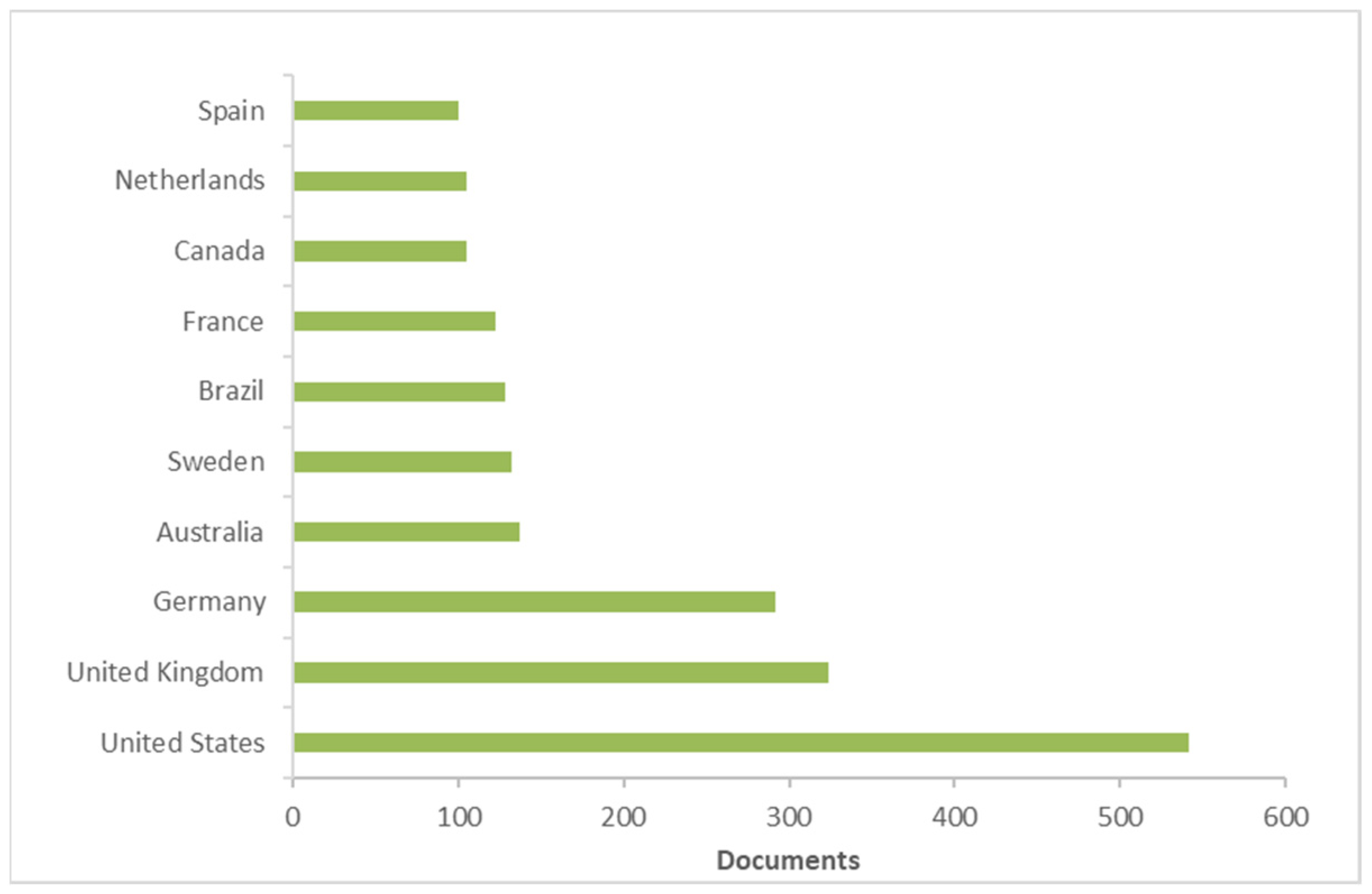

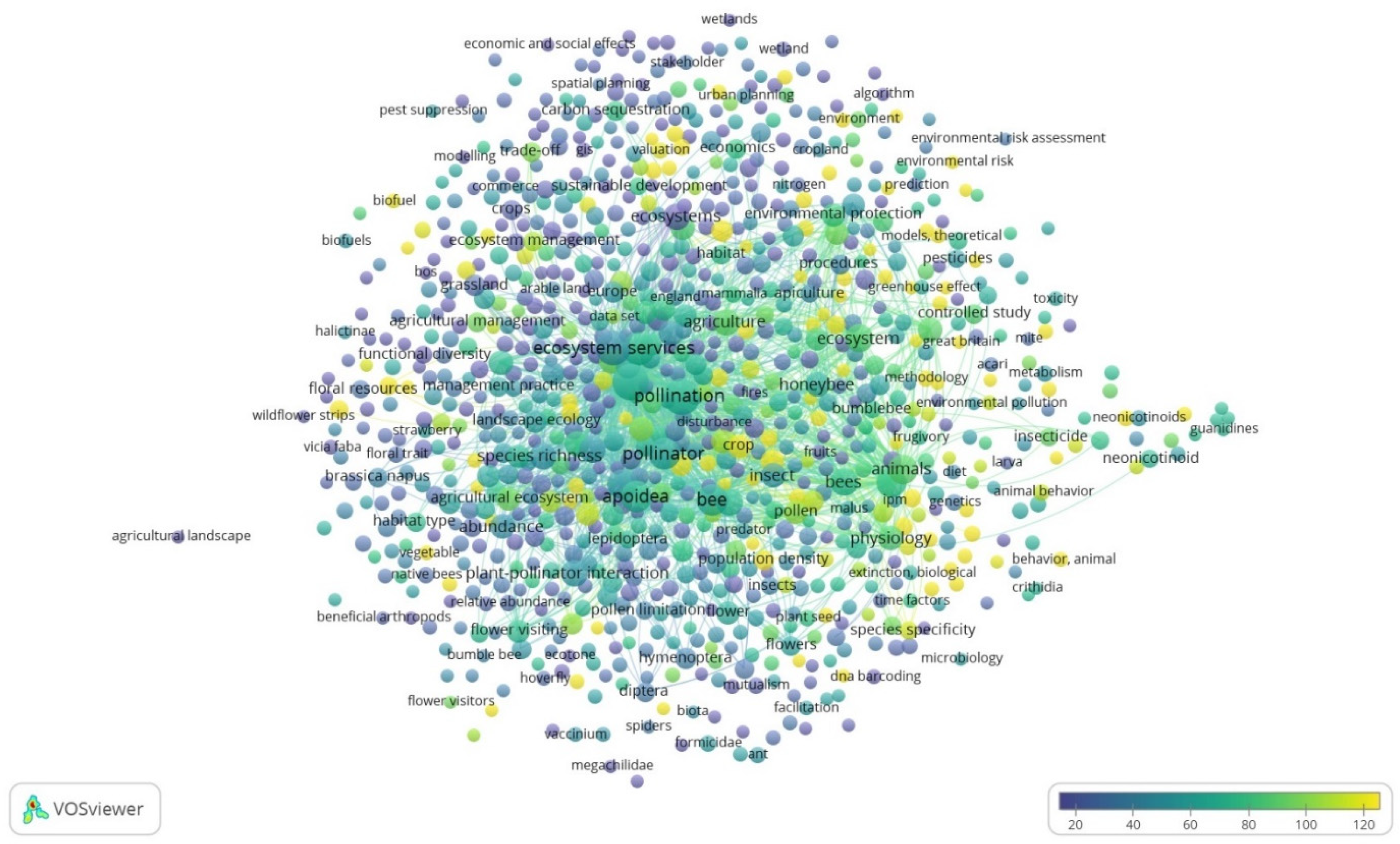
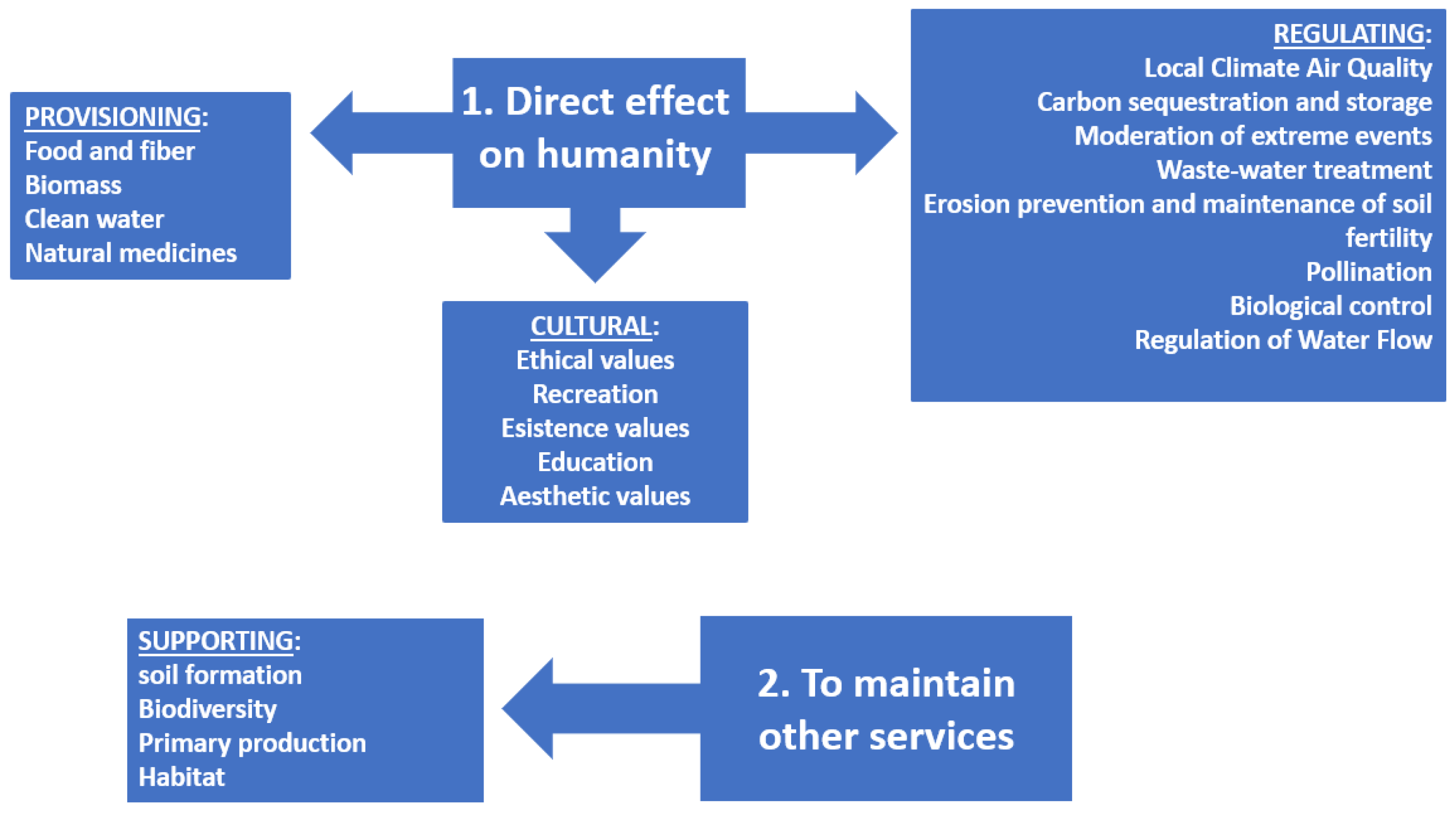
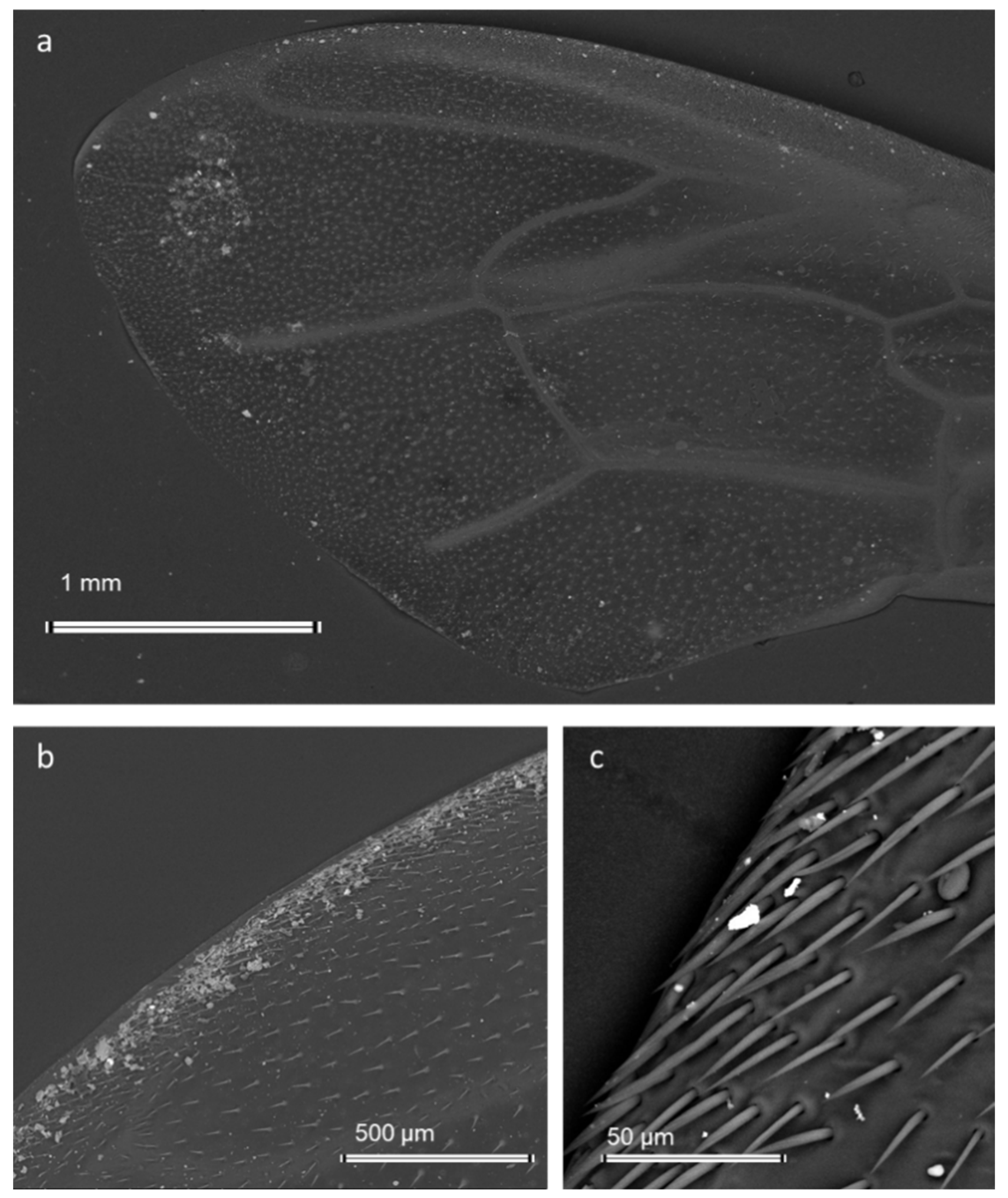
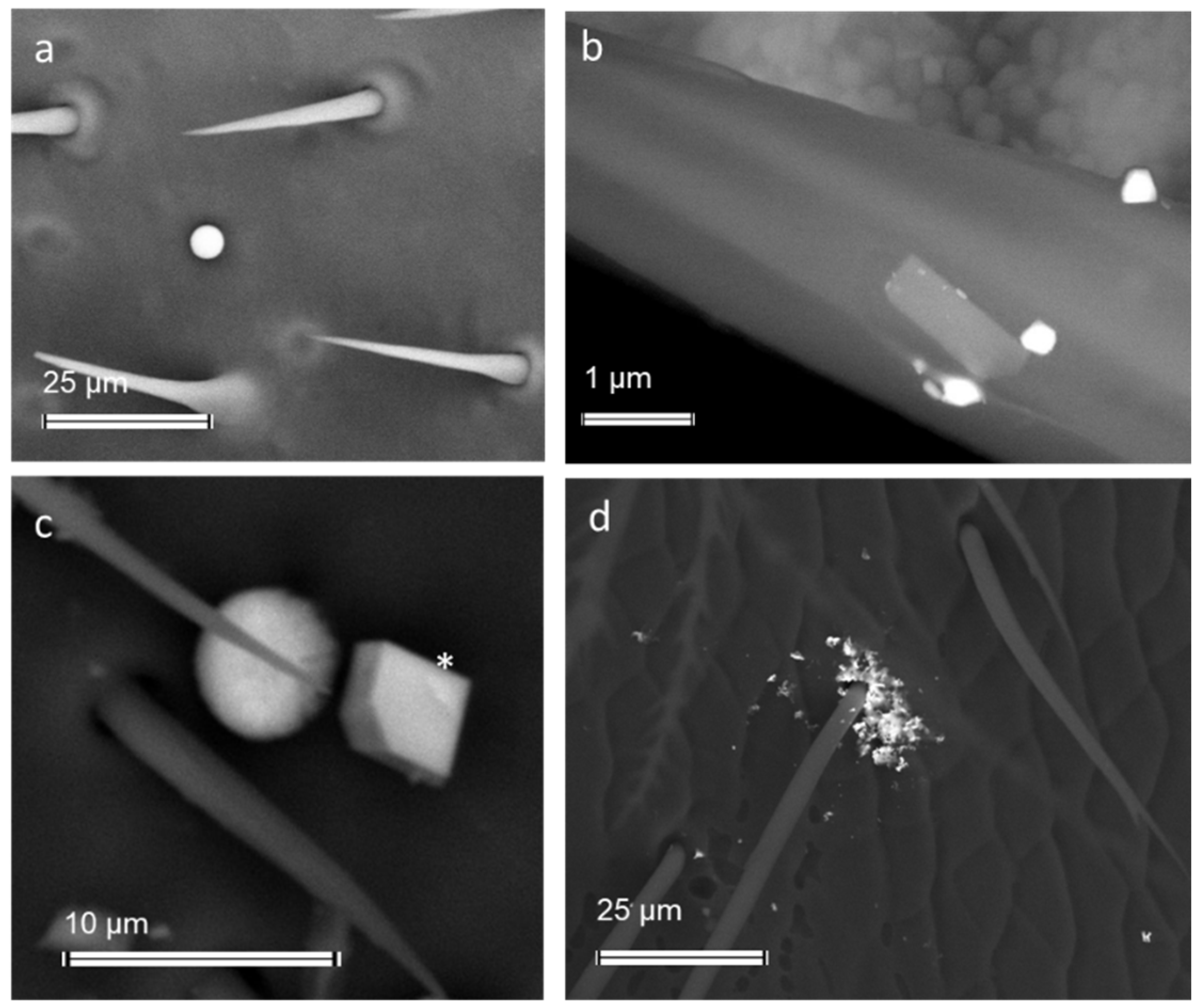

| Regulating Services | |
|---|---|
| Service | Role of trees |
| Pollination | Natural forests are important habitats for pollinators, providing refuge and food. Given a choice, wild honeybees chose nesting places in trees rather than in an open landscape. When enough bees are present in a forest, they provide better pollination that leads to an improved regeneration of trees and conservation of the forest’s biodiversity. |
| Local Climate Air Quality | Urban trees can affect air quality in the following ways: (i) converting carbon dioxide to oxygen through photosynthesis; (ii) intercepting particulate pollutants (dust, ash, pollen, and smoke) and absorbing toxic gases such as ozone, sulphur dioxide, and nitrogen dioxide; (iii) emitting various volatile organic compounds contributing to ozone formation in cities; (iv) lowering local air temperatures; (v) reducing building temperature extremes in both summer and winter and consequently reduce pollution emissions from power-generating facilities. |
| Carbon sequestration and storage | Trees and plants grow, thus removing carbon dioxide from the atmosphere and effectively stocking it away in their tissues. |
| Moderation of extreme events | Extreme weather events and natural disasters are posing an increasing threat to the world’s forests. The condition of forests themselves can influence extreme events. For example, deforestation or poor management can increase flooding and landslides during cyclones. However, the extent of large-scale flooding in the lower parts of major river basins does not seem to be linked to the degree of forest cover or the management practices in the catchment area. Similarly, forests cannot prevent large-scale landslides and mass movements triggered by tectonic or extraordinary rainfall events. |
| Waste-water treatment | Trees contribute heavily to waste-water treatment through their root system and their role in nutrient cycling. |
| Erosion prevention and maintenance of soil fertility | Studies have shown that the more closely an agricultural system resembles a natural forest in its canopy structure, tree spacing, and ground cover, the less chance of soil erosion. Traditional agroforestry techniques, which provide natural cover, have been used for centuries to produce food without causing long-term damage to the environment. |
| Biological control | In a forest, the biological control of pests is often the chosen methodology since the relatively stable environment of a forest guarantees freedom from such adverse effects as interference by pesticides or disturbing agricultural practices. Natural or sustainably managed forests are also a great reservoir of natural pest eradicators. |
| Regulation of Water Flow | Forests influence the amount of water available and the timing of water delivery. Stream-flow regulation by forests results from processes in the forest canopy, on the surface, and below the ground. Sustainable forest management is key to the regulation of water flows. |
| Steps | Action |
|---|---|
| Opening up of forested areas, which created more favorable conditions for bees | Increase |
| Paving highways, which concentrated moisture along roadsides | Increase |
| Introduction of “weeds” upon which the bees forage | Increase |
| Growing numerous crops upon which the bees forage | Increase |
| Bringing desert areas into bloom (with irrigation) | Increase |
| Monitor pollinator decline, its causes, and impact on pollination services | Conservation |
| Address the lack of taxonomic information on pollinators | Conservation |
| Assess the economic value of pollination and the economic impact of the decline of pollinator services | Conservation |
| Promote conservation, restoration, and sustainable use of pollinator diversity in agriculture and related ecosystems | Conservation |
Publisher’s Note: MDPI stays neutral with regard to jurisdictional claims in published maps and institutional affiliations. |
© 2022 by the authors. Licensee MDPI, Basel, Switzerland. This article is an open access article distributed under the terms and conditions of the Creative Commons Attribution (CC BY) license (https://creativecommons.org/licenses/by/4.0/).
Share and Cite
Plutino, M.; Bianchetto, E.; Durazzo, A.; Lucarini, M.; Lucini, L.; Negri, I. Rethinking the Connections between Ecosystem Services, Pollinators, Pollution, and Health: Focus on Air Pollution and Its Impacts. Int. J. Environ. Res. Public Health 2022, 19, 2997. https://doi.org/10.3390/ijerph19052997
Plutino M, Bianchetto E, Durazzo A, Lucarini M, Lucini L, Negri I. Rethinking the Connections between Ecosystem Services, Pollinators, Pollution, and Health: Focus on Air Pollution and Its Impacts. International Journal of Environmental Research and Public Health. 2022; 19(5):2997. https://doi.org/10.3390/ijerph19052997
Chicago/Turabian StylePlutino, Manuela, Elisa Bianchetto, Alessandra Durazzo, Massimo Lucarini, Luigi Lucini, and Ilaria Negri. 2022. "Rethinking the Connections between Ecosystem Services, Pollinators, Pollution, and Health: Focus on Air Pollution and Its Impacts" International Journal of Environmental Research and Public Health 19, no. 5: 2997. https://doi.org/10.3390/ijerph19052997
APA StylePlutino, M., Bianchetto, E., Durazzo, A., Lucarini, M., Lucini, L., & Negri, I. (2022). Rethinking the Connections between Ecosystem Services, Pollinators, Pollution, and Health: Focus on Air Pollution and Its Impacts. International Journal of Environmental Research and Public Health, 19(5), 2997. https://doi.org/10.3390/ijerph19052997










